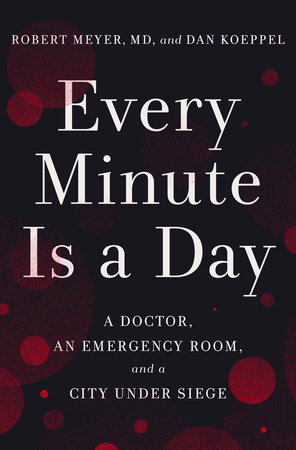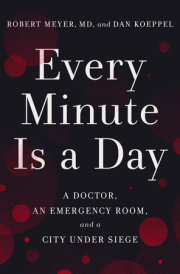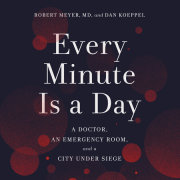Chapter OneIt’s the second Saturday in March, and Governor Andrew Cuomo has just declared a state of emergency, but if you were to look out the doors of the hospital, you’d agree that the word “emergency” is an understatement. Ambulance after ambulance is lined up on Eastchester Road, blocking the drive-throughs at Starbucks and McDonald’s, continuing on toward the elevated railroad tracks and beyond. I can’t even see the end of the line. Staff arriving for work can’t get close enough to the hospital to park there because of the ambulances snaking around the block, idling as they wait.
The nursing homes that surround us can do a lot to treat their own patients, and normally we encounter one of their residents only after a major incident like a heart attack or a fall. But now it feels like we’re seeing all of them. Patients are coming in on stretchers and in wheelchairs with “air hunger”—so starved for oxygen that they’re gasping. Often their families have been notified, so the sick person will wait with anxious sons and daughters, brothers and sisters. Confused relatives wander down the row of ambulances trying to find their loved ones. Today, the entrance to the ER is so crowded that we have to get security to clear it.
“They’re just unloading on us,” one of my colleagues says.
It gets worse after the patients are checked in. Many people who can’t get enough air need to be put on ventilators that will breathe for them, and we’re concerned that we don’t have enough vents. So we’ve had to form an ethics committee—unprecedented in my experience—to determine what we’ll do if the ventilator supply runs dry.
Ventilators require intubation, an art emergency medicine doctors spend a lot of time perfecting. An endotracheal tube must be inserted down a patient’s throat and through the vocal cords. Over the years, the practice has evolved from direct laryngeal intubation—where you basically insert the tube into the airway by sight—to fiber-optic guided intubation, which is a lot more successful. As emergency room doctors, we pride ourselves on being the best at intubating in a crisis, but a lot of factors affect how well an intubation will go. It’s harder with obese patients, ones with shorter necks, and those with trauma.
Often a patient in an emergency room is surrounded by a half dozen people—doctors, nurses, physician’s assistants, respiratory therapists—when they’re being intubated. There’s stuff coming up from their lungs, and the doctor’s face is right over the patient’s open mouth, getting sprayed with respiratory secretions. Sometimes the patient vomits. The moment of intubation is probably the most exposed a doctor can ever be.
Although emergency room doctors can intubate in a crunch, your average anesthesiologist can do it five times more efficiently, because that’s what they do all day. If you’ve ever been put under general anesthesia, you’ve been intubated. Anesthesiologists normally come down to the ER only when we call them in on difficult cases. With the virus spreading quickly, we want them down here performing all our intubations. But the people upstairs don’t understand what’s happening in the emergency room. Even though they’re just a few floors above us, they aren’t seeing what we are seeing. Up there, the status quo still applies.
We’re running out of space. I do a quick count, and there are more than seventy Covid patients in the ER. That’s more than double the number we have room for in the zone we dedicated to Covid care just a few days earlier. And they’re still coming. These patients, who we know have an infectious disease, are all crowded up against one another. They’re crying. They’re praying. And they’re dying.
Nearly all emergency rooms have something called a diversion plan—a predetermined strategy to get the sickest people to another location where they can be seen sooner. Maybe the diversion lasts for an hour, maybe for two hours, maybe, if things are really bad, for a whole day. But in my twenty-five years as an emergency room doctor in the Bronx, I’ve never called for diversion. Montefiore, as a matter of policy, never closes its doors to the community. It’s not what we do. We don’t turn people away. Ever.
At the same time, we’ve never had a Chernobyl before. And that’s what this feels like: a nuclear disaster. I look over at the big yellow milk-crate-sized cases that hold our dwindling supply of ventilators. I don’t want to think about what will happen if we run out.
Emergency room personnel have a job that seems, on the surface, rather narrow: We’re fundamentally about the first sixty minutes of the medical encounter, a period we call the golden hour. We triage, treat, and stabilize, and then move the patient on to the next step—sometimes to another part of the hospital, sometimes home. We rehearse for that golden hour in so many ways. But we don’t train for the type of systemic failure we’re now experiencing.
We have more patients than our team can handle. But we can’t call for diversion, and it’s not just a matter of policy. The other hospitals nearby are going through the same thing. We are all being crushed. There’s no place to divert to.
This failure hurts. Because the thing is, I love this hospital, and I love the Bronx. Sometimes working here is like working in a foreign country, and it’s not just the twenty-five languages that are spoken here. (We translate all of them, through staff who speak different languages or via telephone linkups.) At Montefiore, we see everything tenfold: every hurt, every disease. Some emergency room doctors in the Bronx see more gunshot and stab wounds in a year than most doctors outside New York City and other big urban centers see in their entire careers—although our emergency room doesn’t get a lot of those, since there’s a Level I Trauma Center at Jacobi Medical Center right across the street that’s better equipped to handle patients with such injuries.
After I had been working here for a while, I noticed that patients started putting my colleagues and me down on forms as their primary care doctors. We’re not, but they know us. They know we’ll treat their hyperglycemia when they can’t afford their insulin. We’ll treat their asthma. They know that we’ll never refuse them a bed when it’s cold or they’re hungry. It makes me feel proud that they see us as the place they can turn to. But right now, that pride is being crushed by fear.
Early in my shift, a young patient named Arthur, about thirty years old, waves me over. It’s hectic in the ER, but I feel the need to connect with patients no matter how busy it is. So I walk over and sit on the edge of his bed.
The first thing he does is show me a picture of his kids, and it’s a good move on his part, because I am instantly drawn in. I also have kids, though his are younger. He tells me the oldest one is seven years old, and he’s been dealing with kidney failure. His son is on peritoneal dialysis, which means he has catheters coming out of his belly to remove fluid. Either he or his wife has to manage this, or the boy will die.
I take a quick look at Arthur’s chart and see that he’s reporting that he hasn’t felt well for two weeks. That’s a long time. He’s an electrician, and he’s been out of work. He’s been quarantining in the bathroom of the tiny apartment where he lives with his wife and sick child, afraid to come to the ER.
“I’ve basically been managing my care through 311,” he says. He’s been calling the New York City public information line to figure out what he needs to do if he has certain symptoms—when he can go to work, when he has to stay home. He learned that he could go back to work only if he had a doctor’s note saying he was okay. Then he tells me something that really stuns me.
“I started out with $3,100 in my bank account, Doc,” he says. “I was down to $4, so I had to do it.”
“Had to do what?”
“I figured out what the doctor’s note needed to say, and I wrote it myself.”
He looks at me, and tears start rolling down his face. The letter didn’t work. They saw how sick he was and sent him home.
He has lucked out in that he has pneumonia, not Covid, but he doesn’t know if he is going to be allowed back to work, given his health status. He has an empty bank account and a sick child. What is he going to do?
Covid doesn’t put only patients’ lives at risk. It’s a danger to all of us who work at the hospital. I find myself feeling contempt for them, which is something I have never experienced during my entire career, and I’m ashamed of it. How can a doctor be resentful toward a bunch of sick people? It’s not their fault.
The patients from the nursing homes didn’t ask to be brought here. We’re giving them Tylenol, fluids, and hydroxychloroquine, which seems like a promising remedy but will later be discredited. We’re giving them lots of oxygen, through a face mask or nasal cannula. We intubate them. And still so many die.
Copyright © 2021 by Robert Meyer, MD. All rights reserved. No part of this excerpt may be reproduced or reprinted without permission in writing from the publisher.










